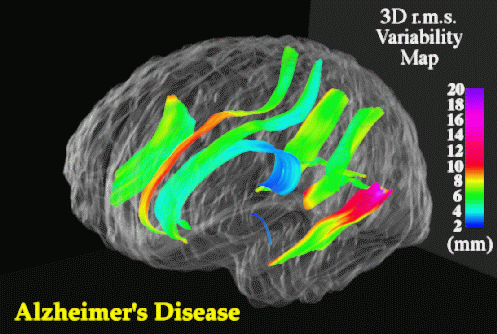Paul M. Thompson, Jacob Moussai, Shahin Zohoori, Amir Goldkorn, Aelia A.
Khan,
Michael S. Mega, Gary W. Small, Jeffrey L. Cummings, Arthur W. Toga
Laboratory of Neuro Imaging and Alzheimer's Disease Center, Department of Neurology, Division of Brain Mapping, UCLA School of Medicine, Los Angeles, California 90095
Full Article (.pdf 612KB)
An Alzheimer's Disease Brain Atlas

Methods. High-resolution 3D T1-weighted fast SPGR (spoiled GRASS) MRI volumes were acquired from 10 patients diagnosed with AD (NINCDS-ARDRA criteria; age: 71.9+/-10.7 yrs) and 10 normal subjects matched for age (72.9+/-5.6 yrs), gender, educational level and handedness. Scans were digitally transformed into Talairach stereotaxic space. To determine specific patterns of cortical variation in dementia patients, 3-dimensional average and probabilistic maps of primary deep sulci were developed for both normal and AD groups. Major sulci (including supracallosal, cingulate, marginal, parieto-occipital, anterior and posterior calcarine sulci and Sylvian fissures) were modeled as complex systems of 3D surfaces using a multi- resolution parametric mesh approach. Variations and asymmetries in their extents, curvature, area and surface complexity were evaluated.
Results. 3D maps of anatomic variability, structural asymmetry and local atrophy indicated severe regionally-selective fiber loss in AD. 24.5% midsagittal area loss at the corpus callosum's posterior midbody (p < 0.025) matched increases in structural variability in corresponding temporo-parietal projection areas. Confidence limits on 3D cortical variation, visualized in 3D, exhibited severe increases in AD from 2-4 mm at the callosum to a peak standard deviation of 19.6 mm at the posterior left Sylvian fissure. Normal Sylvian fissure asymmetries (right higher than left; p < 0.0005) were mapped for the first time in 3 dimensions, and were accentuated in AD (p < 0.0002).
Conclusion. Severe AD-related increases in 3D variability and asymmetry may reflect disease-related disruption of the commissural system connecting bilateral temporal and parietal cortical zones, since these regions are known to be at risk of early metabolic dysfunction, perfusion deficits and selective neuronal loss in AD.
Key Words: Brain Mapping, dementia, cortex, 3D, neuroanatomy, sulcus, Magnetic Resonance Imaging
Paul Thompson
| RESUME| E-MAIL ME| PERSONAL HOMEPAGE| PROJECTS |
|---|